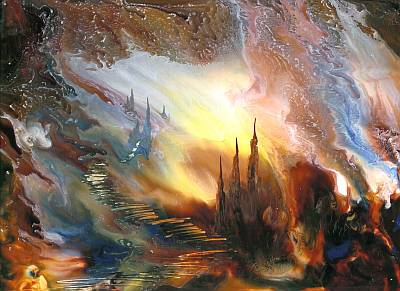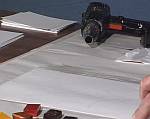 |
Start by covering an A3 orA4 sized card with clear wax
medium. This will enable the coloured waxes to flow easily over the entire
surface rather than develop "dry" pockets or holes where no wax flows.
Do this step diligently as good preparation always pays off!
Watch
a short video clip of blowing this background |
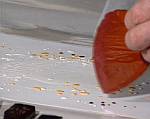 |
Now dribble on the wax colours that you wish to use.
Here the central area was covered in white drops, then yellow was added
around that, but not over the entire card. The central area is left with
just white wax. As the outer areas are coloured darker hues can be used.
These will help "frame" the light that will be developed in the central
area. |
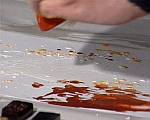 |
The waxes can be dribbled off or smeared on using the iron.
By dribbling you have greater control over the quantities of wax colour
added into the image. Encaustic block colours are very potent, so there
is no real need to develop very much depth of wax to get a vibrant effect.
You just need sufficient to enable movement of the liquid waxes once they
are molten, either by blowing or tilt & pan. |
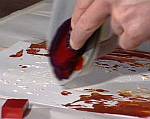 |
The darkest colour is finally added toward the outer edges.
In this example the whole tone of the piece is white - yellow - brown.
So a red brown (No.13) has been used at the outer border to act as the
strength that will create the deepest contrast against the white inner
colour. |
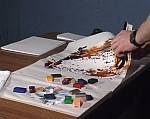 |
Now that the colours are laid in place on the card it is
time to prepare for the blowing action.
The piece is removed from the initial table top where the colours have
been added..... |
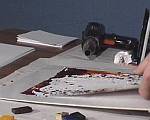 |
..... then placed onto a rigid board that has been covered
with some flat disposable waste paper.
* No tape or fixings have been used here, but you can use some masking
tape if you wish. |
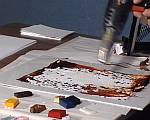 |
Now the hot air gun is switched on. WORK
IN A WELL VENTILATED SPACE. Initially a high heat can
be used to quickly bring the whole piece up to a melting point. You can
notice this when the wax starts to glisten. Once it is just about melting
switch to a lower heat or you will burn the wax, creating smoke. ANY
SMOKE IS A SIGN THAT THINGS ARE OVERHEATING!
*
The key to success
is to ensure that the hot air nozzle is kept dancing around all the time,
never dwelling in one place. |
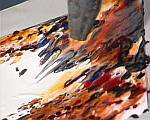 |
As the wax starts to melt and flow it is time to begin lifting
the rigid board that the waxed card is resting upon and tilting it so that
the wax flows out to cover all traces of the original card's surface.
Keep that nozzle moving all the time or you will find the wax getting
very thin and over hot. |
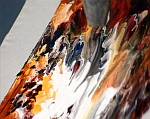 |
If you have too much wax it will flow fast and be difficult
to control. You are able to affect the speed of flow by altering the angle
of tilt. A high angle where the board is almost vertical will create the
fastest flow. Low or flatter angles will reduce the speed of flow, but
if there is too much wax it will blend and puddle, leaving you with less
control on how it mixes and blends. |
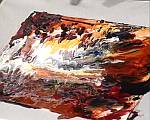 |
Once the whole area is covered, taking care to ensure
the edges are not missed, it is time to develop the light in the central
area and find ways to help it spread outwards. All imagery depends on
the contrast of light and dark (unless it is one single tone).
So here, the hot air is now directed into the central area .... |
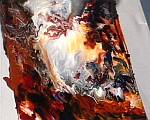 |
... and the colours are gently encouraged outward, both
by blowing and pan& tilt tipping of the board.
* Remember, a lower angle will reduce the speed of the flowing wax.
By panning as well as tilting you are able to direct the wax in any of
the 180degree direction options. |
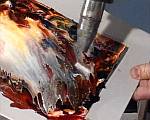 |
Tease the lighter colours outwards, working lightly and
gently over the darker outer bordering ones.
* Be prepared for some of the wax colour to flow right off the board,
onto the work surface underneath. Make sure you have some protective
paper there to catch this spent wax. |
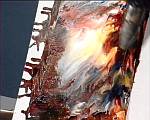 |
You can see now that the wax colour is being driven across
the card in an angled direction, not quite corner to corner. In the final
image this gives the feeling of expansion or bursting out.
KEEP THE NOZZLE
ON THE MOVE!
* You can see on the left side here, how the wax has over-shot the
actual painting card area. |
 |
Almost finished!
Notice the spots of spent wax on the waste paper beneath. You can see the
colour streams at the bottom edge of the work piece as excess spent wax
flows off.
When you are content, turn off the hot air gun. Place
it safely on a non-combustible surface. LAY THE WORK FLAT TO
COOL. |
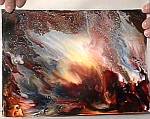 |
Once the wax is cool the forms and blends are
fixed, unless you re-heat the piece.
Now you can decide if further work is necessary or not.
Sometimes it is not at all necessary to add anything. These abstract swirls
and hot air blends offer much opportunity for creativity. |
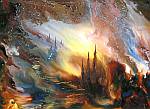 |
The background has been developed into a fantasy piece now,
simply by adding some illusions of perspective. Vertical spires encourage
imagination of castles and the winding diminishing horizontal lines suggest
steps or a pathway. All these have been added with consideration that it
is the strongest light that pulls the eye. The fantasy elements merely
encourage that direction, enhancing, not fighting. |
|
|










